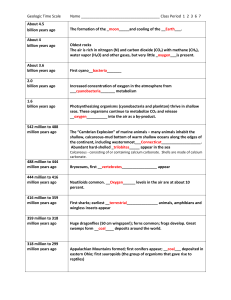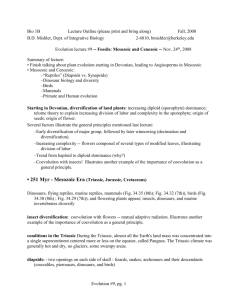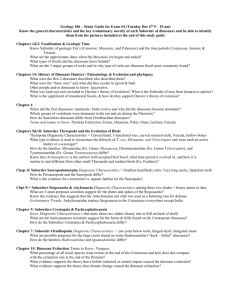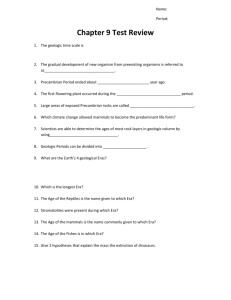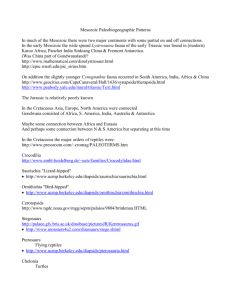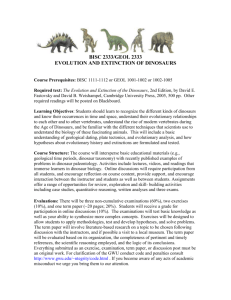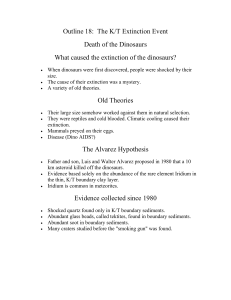chapter 15 - answers to questons in text
advertisement
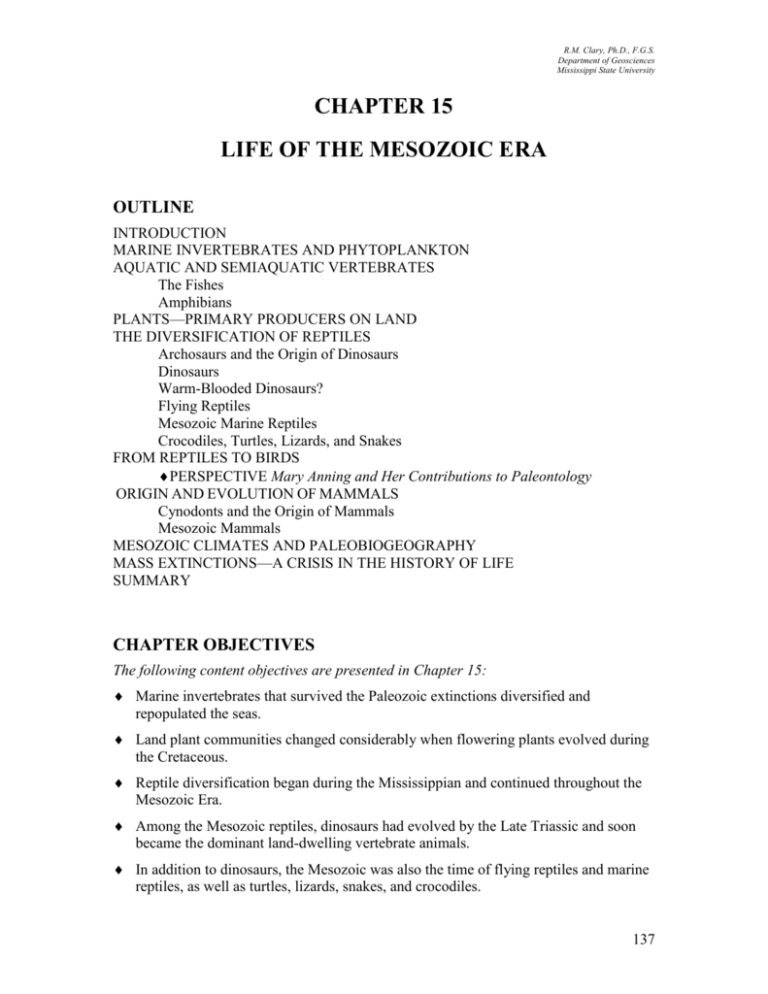
R.M. Clary, Ph.D., F.G.S. Department of Geosciences Mississippi State University CHAPTER 15 LIFE OF THE MESOZOIC ERA OUTLINE INTRODUCTION MARINE INVERTEBRATES AND PHYTOPLANKTON AQUATIC AND SEMIAQUATIC VERTEBRATES The Fishes Amphibians PLANTS—PRIMARY PRODUCERS ON LAND THE DIVERSIFICATION OF REPTILES Archosaurs and the Origin of Dinosaurs Dinosaurs Warm-Blooded Dinosaurs? Flying Reptiles Mesozoic Marine Reptiles Crocodiles, Turtles, Lizards, and Snakes FROM REPTILES TO BIRDS PERSPECTIVE Mary Anning and Her Contributions to Paleontology ORIGIN AND EVOLUTION OF MAMMALS Cynodonts and the Origin of Mammals Mesozoic Mammals MESOZOIC CLIMATES AND PALEOBIOGEOGRAPHY MASS EXTINCTIONS—A CRISIS IN THE HISTORY OF LIFE SUMMARY CHAPTER OBJECTIVES The following content objectives are presented in Chapter 15: Marine invertebrates that survived the Paleozoic extinctions diversified and repopulated the seas. Land plant communities changed considerably when flowering plants evolved during the Cretaceous. Reptile diversification began during the Mississippian and continued throughout the Mesozoic Era. Among the Mesozoic reptiles, dinosaurs had evolved by the Late Triassic and soon became the dominant land-dwelling vertebrate animals. In addition to dinosaurs, the Mesozoic was also the time of flying reptiles and marine reptiles, as well as turtles, lizards, snakes, and crocodiles. 137 R.M. Clary, Ph.D., F.G.S. Department of Geosciences Mississippi State University Birds evolved from reptiles, probably from some small carnivorous dinosaur. Mammals evolved from reptiles only distantly related to dinosaurs, and they existed as contemporaries with dinosaurs. The transition from reptiles to mammals is very well supported by fossil evidence. Several varieties of Mesozoic mammals are known, all of which were small, and their diversity remained low. The proximity of continents and generally mild Mesozoic climates allowed many plants and animals to spread over extensive geographic areas. Extinctions at the end of the Mesozoic Era were second in magnitude only to the Paleozoic extinctions. These extinctions have received more attention than any others because dinosaurs were among the victims. LEARNING OBJECTIVES To exhibit mastery of this chapter, students should be able to demonstrate comprehension of the following: the repopulation of the seas by marine invertebrates following the Paleozoic mass extinction the increasingly diverse and complex Mesozoic marine invertebrate communities changes in the composition of land-plant communities, especially with the appearance of angiosperms the archosaurs and the origin of the dinosaurs the diversity and adaptations of dinosaurs and other reptiles the fossil evidence for the transition from mammal-like reptiles to mammals the evolution of birds from reptiles the divergence of Mesozoic mammals the relationship of plate tectonics, paleoclimates, and the geographic distribution of plants and animals the possible causes and significance of the terminal Cretaceous extinction CHAPTER SUMMARY 1. Invertebrate survivors of the Permian extinctions repopulated the seas and gave rise to increasingly diverse marine communities. Figure 15.1 Cretaceous Seascape 138 R.M. Clary, Ph.D., F.G.S. Department of Geosciences Mississippi State University 2. Some of the most abundant invertebrates were cephalopods (especially ammonoids), foraminifera, and the reef-building rudists. Figure 15.2 Belemnoids Figure 15.3 Planktonic Foraminifera Figure 15.4 Primary Producers 3. Sharks and other cartilaginous fishes became more abundant during the Mesozoic, but they never came close to matching the diversity of the bony fishes. The bony fishes belong to three groups. The advanced group, teleosts, became the most diverse of all bony fishes by the Cretaceous. Frogs and salamanders were present by the Mesozoic. Figure 15.5 The Mesozoic Fish Leedsichthys and the short-Necked Plesiosaur Liopluerodon 4. Land plant communities of the Triassic and Jurassic consisted of seedless vascular plants and gymnosperms. The angiosperms, or flowering plants, evolved during the Early Cretaceous, diversified rapidly, and were soon the most abundant land plants. Figure 15.6 Mesozoic Vegetation Figure 15.7 The Angiosperms or Flowering Plants 5. Dinosaurs evolved from small, bipedal archosaurs during the Late Triassic, but were most common during the Jurassic and Cretaceous periods. Figure 15.8 Relationships Among Fossil and Living Reptiles and Birds 6. Dinosaurs differ enough that two distinct orders are recognized: the Saurischia and the Ornithischia. Figure 15.9 Cladogram Showing Relationships Among Dinosaurs Figure 15.10 Theropod Dinosaurs were Bipedal Carnivores Table 15.1 Summary Chart for the Orders and Suborders of Dinosaurs Figure 15.11 Hadrosaurs or Duck-billed Dinosaurs Figure 15.12 Representatives of Two of the Five Groups of Ornithischians Enrichment Topic 1. The Tyrannosaurus’ Growth Spurt New analysis of ribs of Tyrannosaurus rex indicated that the dinosaurs grew quickly in their “teenage” years. Researchers investigated bones that do not bear weight—such as ribs and shinbones—and were able to accurately predict the ages of modern alligators and lizards of known ages. The researchers discovered that T. rex grew up fast, with most of its growth occurring between the ages of 14 and 18 years. The researchers hypothesized that as the animal got larger, it probably suffered a decline in its running ability. Nature News, August 2004, http://www.nature.com/news/2004/040809-7/ Enrichment Topic 2. Coprology Coprolites, or fossilized fecal material, are providing a multitude of data towards understanding the biology of the organisms that produced them. A Tyrannosaurus coprolite, 65 cm in length, contained bone fragments and preserved fibers. Researchers determined the bone fragments were consistent with pachycephalosaurs. 139 R.M. Clary, Ph.D., F.G.S. Department of Geosciences Mississippi State University This research supports the hypothesis that the tyrannosaurs did not retain their food in their guts for long periods of time. Geology Today, July-Aug. 2004, v.20 n.4 p.129 7. Bone structure, predator-prey relationships, and other features have been cited as evidence of dinosaur endothermy. Although there is still no solid consensus, many paleontologists think some dinosaurs were indeed endotherms. 8. That some theropods had feathers indicates that they were warm-blooded and provides further evidence of their relationship to birds Figure 15.13 Feathered Dinosaur Enrichment Topic 3. Parental Care in Dinosaurs Researchers assessed parental care of Cretaceous toodontid and oviraptorid dinosaur by examining clutch volume and the bone histology of brooding adults. The large clutch volumes of Troodon, Oviraptor, and Citipati most closely compared with a bird-paternal care model. Paternal care in both troodontids and oviraptorids indicates that the paternal care system evolved before the emergence of birds, and represents birds’ ancestral condition. Varricchio, Moore, Erickson, Norell, Jackson, and Borkowski, “Avian Paternal Care Had Dinosaur Origin,” Science, 2008, v. 322, issue 5909, p. 1826-1828. 9. Pterosaurs, the first flying vertebrates, varied from sparrow size to comparative giants. The larger pterosaurs probably depended on soaring to stay aloft, whereas smaller ones flapped their wings. At least one species had hair or hairlike feathers. Figure 15.14 The Pterosaurs (Flying Reptiles) Enrichment Topic 4. Pterosaur and Bird Embryos Indicate Flight. A fossilized embryo of a pterosaur that was discovered in China dates to 121 million years ago. The embryo was identified as a pterosaur through its sturdy upper arm bone and elongated fourth finger. The surprising discovery was that the embryo was unusually advanced with the membranes of its five-inch wings already developed. The researchers believed that the pterosaurs could fend for themselves after hatching, and could probably fly immediately. Discover, Jan. 2005 v.26 n.1 In a parallel discovery of an early bird embryo, scientists noted that the complete feather structures, the embryo’s large skull, and ossified bones indicated that the baby birds were able to fend for themselves soon after hatching. In addition, the curved claws of the embryo indicated that the birds would have spent much of their time in the trees. Science News, Oct. 23, 2004 v.166 n.17 p.261. 10. The fish-eating, porpoiselike ichthyosaurs were thoroughly adapted to an aquatic environment, whereas the plesiosaurs with their paddle-like limbs could most likely come out of the water to lay their eggs. The marine reptiles known as mosasaurs were most closely related to lizards. Figure 15.15 Mesozoic Marine Reptiles 140 R.M. Clary, Ph.D., F.G.S. Department of Geosciences Mississippi State University Enrichment Topic 5. Aquatic Reptiles of the Mesozoic A discovery in China of an aquatic reptile, Dinocephalosaurus orientalis, has led researchers to propose that the animal’s throat could open and create a suction to “vacuum” in its prey. The ribs of the neck appear to have made the neck stiff and inflexible, but protusions on the cervical ribs suggested to the paleontologists that the ribs were used in hunting. By contracting the neck vertebrae, the ribs would have splayed, increasing the diameter of the esophagus. The created suction would have pulled water— and prey—into the animal’s mouth. Although some fish and turtles capture prey by suction, the mechanism proposed for this reptile would have created a greater force. Science News, Sept. 25, 2004, v.166 n.13 p.166. 11. During the Jurassic, crocodiles became the dominant freshwater predators. Turtles and lizards were present during most of the Mesozoic. By the Cretaceous, snakes had evolved from lizards. 12. Jurassic-aged Archaeopteryx, the oldest known bird, possesses so many theropod characteristics that it has convinced most paleontologists the two are closely related. Figure 15.16 Archaeopteryx from the Jurassic-age Solnhofen Limestone of Germany Enrichment Topic 6. The Bird-Brained Archaeopteryx Researchers confirmed that Archaeopteryx had a brain and body geared for flight. Researchers used computed tomography (CT) to investigate the brain case of the first Archaeopteryx specimen. The scientists believed that the bird had enlarged brain regions for vision and movement control, parallel to modern birds. The inner ear structure was also bird-like, as well as its brain-to-body size ratio. The researchers concluded that Archaeopteryx was more bird-like than first believed. Nature News, August 2004, http://www.nature.com/news/2004/040802/ Researchers also recently hypothesized that Archaeopteryx used hind leg feathers to improve its flight. Although scientists originally thought these hind leg feathers were for insulation and streamlining, reanalysis of the structures indicated that they functioned like small auxiliary wings. Science News Sept. 23, 2006 v.170 p.197. 13. Mammals evolved by the Late Triassic, but they differed little from their ancestors, the cynodonts. Minor differences in the lower jaw, teeth, and middle ear differentiate one group of fossils from the other. Figure 15.17 Evolution of the Mammal Jaw and Middle Ear Table 15.2 Summary Chart Showing Some Characteristics and How They Changed during the Transition from Reptiles to Mammals Figure 15.18 Comparison of the Teeth of a Mammal and a Reptile 14. Several types of Mesozoic mammals existed, but most were small, and their diversity was low. Both marsupial and placental mammals evolved during the Cretaceous from a group known as eupantotheres. 141 R.M. Clary, Ph.D., F.G.S. Department of Geosciences Mississippi State University Figure 15.19 Relationships Among the Early Mammals and their Descendants Figure 15.20 Restorations of the Oldest Known Marsupial and Placental Mammals Enrichment Topic 7. Dinosaur-Eating Mammals. Before the discovery of mammalian Mesozoic fossils in China, most paleontologists believed that mammals of the Mesozoic were small and insectivorous. However, one fossil, Repenomamus robustus, was found to contain the remains of its last meal—a young juvenile Psittacosaurus. The mammal was probably 9 to 13 pounds in size and less than 1.5 feet in length when it was alive. The discovery was important because it offered proof that mammals also preyed upon dinosaurs. Geotimes, March 2005 v.50 n.3 p.8-9. 15. Because during the Mesozoic the continents were close together and climates were mild, plants and animals occupied much larger geographic ranges than they do now. 16. Among the victims of the Mesozoic mass extinctions were dinosaurs, flying reptiles, marine reptiles, and several groups of marine invertebrates. A huge meteorite impact may have caused these extinctions, but some paleontologists think other factors were important, too. Figure 15.21 End of Mesozoic Extinctions Enrichment Topic 8. Arctic Dinosaur Fossils Contradict Dinosaur Decline Fossils uncovered in the Arctic support a sudden dying of dinosaurs. This contradicts some paleontologists’ beliefs that extinction of dinosaurs was gradual and in decline when a meteorite hit. Pascal Godefroit and his colleagues described fossils from northeastern Russia that suggested that dinosaurs were not in decline at all. These fossils are dated between 68 and 65 million years old, just before the extinction event. Dinosaur eggshells and fossils of duck-billed hadrosaurs as well as theropods indicate a healthy polar population. Not all scientists are in agreement with the interpretation of the data, however. Kaplan, “Dinosaur Fossils Suggest Speedy Extinction,” Nature News, January 20, 2009. LECTURE SUGGESTIONS Mary Anning and the History of Science Mary Anning, as well as many of the other pioneering geologists during the Golden Age of Geology (1798-1840) investigated Mesozoic fossils. The history of science can be brought into the classroom by using selected readings, research initiatives, and/or Interactive Historical Vignettes (IHVs). In the IHV format, the instructor and/or students present brief skits that reveal the history and nature of science. Two IHVs on Mary Anning’s life have been written. Clary & Wandersee, “Mary Anning: She’s More than ‘Seller of Sea Shells at the Seashore,” The American Biology Teacher Mar. 2006, v.139 n.3 p.153-157; Wandersee & Clary, “Interactive Historical Vignette: The Scientific 142 R.M. Clary, Ph.D., F.G.S. Department of Geosciences Mississippi State University Endeavors of Mary Anning, the First Woman Paleontologist, Teaching and Learning Science: A Handbook, K. Tobin, Ed. (2007). The Ruling Reptiles 1. Introduce students to the dominating roles that reptiles played during the Mesozoic in the seas, the skies, and on the land. Stress that not all of the reptiles that lived during the Mesozoic were dinosaurs. 2. The premier soap opera of paleontology may be the saga of the dinosaur searchers, particularly Edward Drinker Cope and Othneil Charles Marsh. In the rush to discover dinosaur fossils and name new species, competition was fierce and each man publicly tried to out-maneuver the other. In spite of the competition, mistakes were eventually corrected, and science advanced. A brief background history of the feud, as well as suggestions for incorporating the Bone Wars into the classroom, are included in Clary, Wandersee, & Carpinelli, 2008. “The Great Dinosaur Feud: Science Against All Odds,” Science Scope, v. 32, no. 2, p. 34-40. 3. The affiliation of birds with reptiles cannot be denied, especially with the new fossil discoveries in China of feathered dinosaurs. Discuss with students whether the relationship between amphibians and reptiles, reptiles and birds, or reptiles and mammals is closest. Some paleontologists state that the “non-flying dinosaurs went extinct at the end of the Cretaceous.” Is this a valid statement? Why or why not? The Terminal Mesozoic Extinction 1. There is much information written at an introductory level about the Cretaceous mass extinction. Students can be divided into groups to investigate various causes, including a) meteorite impact, b) voluminous volcanism in the Deccan Traps, c) global cooling, and other hypotheses. All groups should be prepared to debate this topic and present sound scientific arguments for their cases, as well as against the other possible hypotheses. An impartial outside committee, such as a college speech class, may be brought in to evaluate the debate. 2. Students may also predict which niches will be available at the beginning of the Cenozoic Era. How is the world different—regardless of the cause for the extinctions? Students may hypothesize why some organisms survived (such as crocodiles) while other species went extinct. 143 R.M. Clary, Ph.D., F.G.S. Department of Geosciences Mississippi State University CONSIDER THIS 1. Because so much controversy surrounds the Cretaceous mass extinction, have students formulate a hypothesis as to what would happen on Earth if similar-sized meteorite to the Yucatan bolide impacted today. Would humans survive? What habitats would be destroyed? Would there be global warming or cooling? 2. How would the world be different today if some dinosaurs survived the Mesozoic mass extinction? Would mammals have risen to a dominating position in the Cenozoic? 3. How do you think natural selection in the marine community was affected during the Cretaceous with the Cretaceous Interior Seaway connecting the Arctic and the Gulf? How might natural selection have proceeded on the western margin of North America as compared to the eastern margin? IMPORTANT TERMS angiosperm Archaeopteryx archosaur bipedal cynodont dinosaur ectotherm endotherm ichthyosaur iridium anomaly marsupial mammal monotreme mosasaur Ornithischia placental mammal plesiosaur pterosaur quadrupedal Saurischia therapsid SUGGESTED MEDIA Videos 1. PaleoWorld, Flight of the Pterosaurs, The Learning Channel 2. PaleoWorld, Dinos in the Air, The Learning Channel 3. PaleoWorld, Early Birds, The Learning Channel 4. PaleoWorld, The Legendary T. Rex, The Learning Channel 5. PaleoWorld, Carnosaurs: The Giant Predators, The Learning Channel 6. PaleoWorld, Dino Doctors, The Learning Channel 7. NOVA: The Four Winged Dinosaur, WGBH 8. PaleoWorld, Ancient Crocodiles, The Learning Channel 9. PaleoWorld, Earthshakers, The Learning Channel 10. PaleoWorld, Flesh on the Bone, The Learning Channel 11. PaleoWorld, Dino Sex, The Learning Channel 12. PaleoWorld, Horns and Herds, The Learning Channel 13. PaleoWorld, Monsters on the Move, The Learning Channel 14. PaleoWorld, Mystery of Dinosaur Cove, The Learning Channel 15. PaleoWorld, Troodon Dinosaur Genius, The Learning Channel 16. PaleoWorld, Sea Monsters, The Learning Channel 17. Chased by Dinosaurs, BBC 18. Walking with Dinosaurs, BBC 144 R.M. Clary, Ph.D., F.G.S. Department of Geosciences Mississippi State University 19. Chased by Sea Monsters, The Discovery Channel 20. When Dinosaurs Roamed America, The Discovery Channel 21. Life on Earth: Lords of the Air, BBC 22. Life on Earth: The Rise of the Mammals, BBC 23. Lost Worlds, Vanished Lives, The Rare Glimpses, BBC 24. Lost Worlds, Vanished Lives, Dinosaur, BBC 25. Utah’s Dino Graveyard, Discovery Channel 26. The Wollemi Pine: A Tree from the Age of Dinosaurs, Science Screen Report 27. Death of the Dinosaurs, BBC 28. Fossils: Reptiles and Mammals, Films for the Humanities and Sciences 29. Dinosaur: Fossils and Paleontology in Dinosaur National Monument, Intermountain Natural History Association 30. Life in the Mesozoic Times, Physical Geology II Series Slides and Demonstration Aids 1. Fossils, Dinosaurs, and Their World, Educational Images, Ltd. 2. Mesozoic Fossil Collection, Science Stuff CHAPTER 15 - ANSWERS TO QUESTONS IN TEXT Multiple Choice Review Questions 1. 2. 3. 4. a d b b 5. 6. 7. 8. d e b d 9. c 10. a Short Answer Essay Review Questions 11. Cynodont jaw and skull bones modified into two of the three mammalian ear bones. One of the reptilian jaw bones became the single mammalian dentary bone, and teeth differentiated more extensively. The secondary palate completely separated the mouth from the nasal passages to facilitate breathing while eating. 12. In Archaeopteryx, bird-like features include feathers and a wishbone, consisting of fused clavicles. Although it also has reptilian features (a tail and teeth), the combination of the wishbone and feathers make it a bird by definition. 13. The dominant geological event of the Mesozoic was the breakup of Pangaea. However, for much of the Mesozoic, close connections still existed between the various landmasses. Also, the Mesozoic climate tended to be mild, lacking the strong north and south zones that Earth currently has. Mesozoic plants and animals had greater opportunities to occupy much more extensive geographic ranges than today. 145 R.M. Clary, Ph.D., F.G.S. Department of Geosciences Mississippi State University 14. The two primary lines of evidence for a large meteorite impact at the end of the Cretaceous are the worldwide distribution of the iridium layer at many CretaceousPaleogene boundary sites and the 65 million year old Chicxulub meteorite impact site in the Yucatan, which has shocked quartz, tektites, and chaotic sedimentary deposits. 15. The early mammals diverged into two distinct branches. One branch includes the triconodonts, and their probable descendants, the monotremes, or egg-laying mammals. The other branch includes the marsupial mammals and the placental mammals. The ancestor of these mammals is the eupantotheres. 16. Pterosaurs have an extended 4th finger to support the wing membrane, hollow bones, and a keeled breastbone for the attachment of flight muscles. Their brains were modified for improved vision and muscle control. 17. In the Triassic, the large seed ferns were around but became extinct by the end of the period. Ginkgos remained abundant, and conifers continued to diversity. The cycads made their appearance during the Triassic. The Jurassic landscape was dominated by seedless vascular plants, especially ferns, as well as gymnosperms including conifers and cycads. In the Cretaceous, flowering plants replaced many of the seedless vascular plants and gymnosperms. They predominate even today, and are successful because they have evolutionary advantages of having enclosed seeds and flowers, which attract pollinators. 18. Ornithischian dinosaurs were mostly quadupeds with bird-like pelvises, and all were herbivores. Armored forms were common. Ornithischians included pachycephalosaurs, ceratopsians, ankylosaurs, stegosaurs, and ornithopods. Saurischians, dinosaurs with lizard-like pelvises, included both herbivores (mostly sauropods) and carnivores (theropods). 19. There is evidence for endothermy in at least some dinosaurs, especially the theropods and some ornithopods. This evidence includes (a) a similarity of their bones to those of endotherms, although they are also similar to those of some ectotherms; (b) a predator to prey ratio that more closely resembles that of endotherms, although again this is uncertain since the fossil record is not always representative of who and how many were around; (c) an endotherm-like brain size, particularly in the small- and medium-sized theropods; (d) the relationship of theropods to birds, since only endotherms have hair, fur, or feathers for insulation; (e) the growth rate of some duck-billed dinosaurs, which resembles that of endotherms; and (f) a fossil ornithopod, which has a four-chambered heart, much like living birds and mammals. Large sauropods were probably not endothermic; they likely retained heat effectively because of their size. 146 R.M. Clary, Ph.D., F.G.S. Department of Geosciences Mississippi State University 20. Following the Paleozoic mass extinction, the invertebrate fauna of the Early Triassic was not very diverse. However, mollusks, such as cephalopods, bivalaves, and gastropods became important elements of the Mesozoic marine invertebrate fauna. The ammonoids are excellent guide fossils for this era. Mesozoic bivalves diversified to inhabit many epifaunal and infaunal niches. Oysters and clams became diverse and abundant. Rudist bivalves were important reef-builders, although schleractinian corals also evolved. A major difference is the increased abundance and diversity in the Mesozoic of burrowing organisms. Bivalves and echinoids were the primary burrowers. Apply Your Knowledge 1. The similarity of shapes is a result of convergent evolution, and ichthyosaurs are not the ancestors of porpoises. Ichthyosaurs were extinct marine reptiles, and the fossils of ichthyosaurus Utatsusaurus resemble a lizard with legs, providing evidence of its evolution from reptiles. Porpoises, however, are mammals. As mammals, they have hair or fur, mammary glands, and give birth to live young. (Although ichthyosaurs are suspected of giving birth to live young, the females retained eggs within their bodies; they were not placental mammals as porpoises are.) There is further evidence showing the evolution of aquatic mammals from land-dwelling mammalian ancestors. So, although the two organisms resemble each other in form, it is strictly caused from convergent evolution as natural selection favored these similar characteristics in very different organisms. 2. The limestone beds with trilobites and brachiopods were deposited during the Paleozoic Era. (Trilobites were extinct by the Mesozoic.) The beds were originally deposited horizontally, but some tectonic event was later responsible for their tilt (using the principle of original horizontality). The surface between the tilted beds and the overlying volcanic ash represents an unconformity, specifically an angular unconformity. The ash was deposited after an erosional event occurred, and this was followed by deposition in the Mesozoic of the sandstone beds. (The sandstone beds must be Mesozoic because of the dinosaur fossils). These beds were originally deposited horizontally as well. The basalt dike is the youngest rock body in these rocks (principle of cross-cutting relationships). It is also possible to determine absolute ages for the ash layer and the basalt dike because igneous rocks can be radiometrically dated. 3. Student responses will vary, but should consider the similarities between saurischians and ornithischians (as shown in Figure 15.8, p. 307), which arose from an ancestral archosaur. Birds and the suarischians should be more closely related, as bird evolved from theropod dinosaurs (Figure 15.8, p. 307). The relationship between cynodonts and mammals should resemble Figure 15.19, p. 320. Placement of the cynodonts (therapsids) and the archosaur (thecodonts) should resemble Figure 13.17, p. 270. 147 R.M. Clary, Ph.D., F.G.S. Department of Geosciences Mississippi State University 4. The most obvious features of living mammals are endothermy (warm-bloodedness), hair or fur, and mammary glands. Living crocodiles have none of these features. Crocodiles are ectothermic, hairless, and produce via amniote egg. Additionally, crocodiles have one small bone in the middle ear (as opposed to three for mammals), and while a mammal’s jaw has one bone, a crocodile’s jaw is composed of several bones. Additionally, crocodiles’ teeth are not differentiated as mammal teeth are. 148
